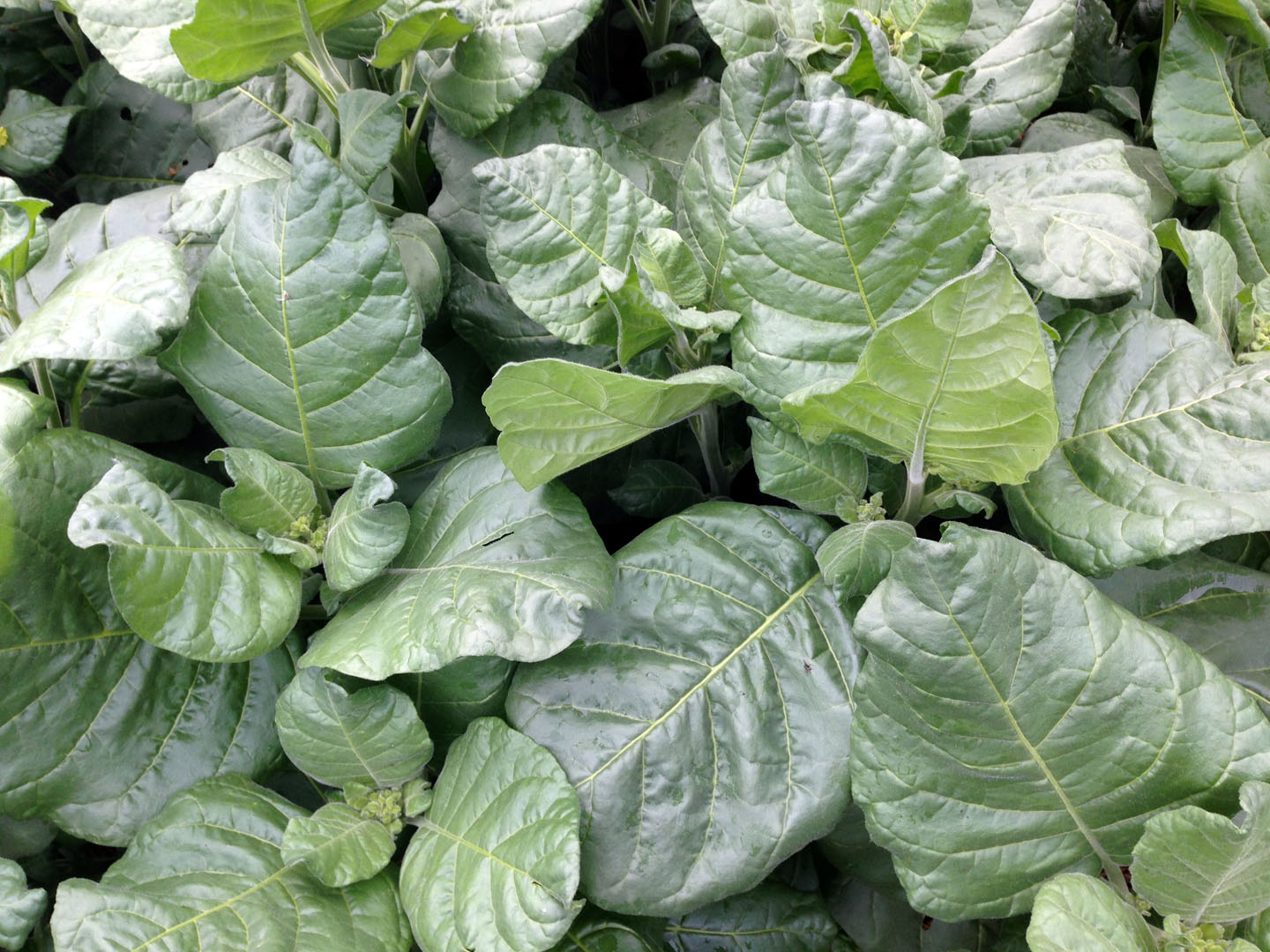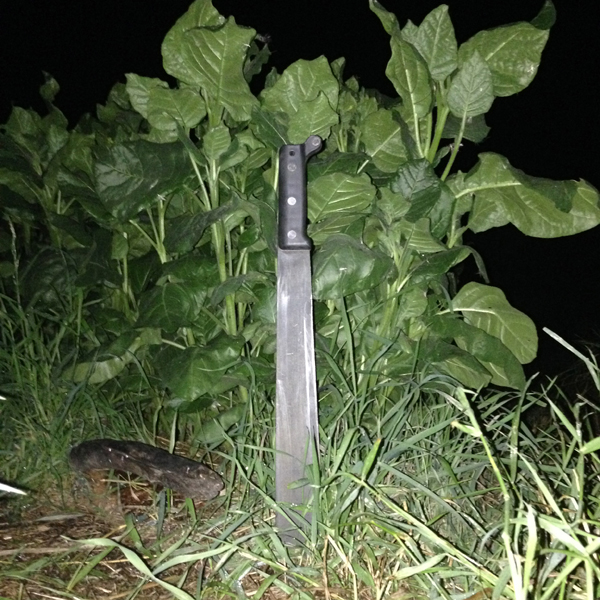
Growing Tobacco, Making Mapacho
Tobacco is a tremendous force, one of my closest friends and I love it. Specifically the deep, rich, dark, strong, heavy, thick and real tobacco of the Amazon, Mapacho. The black tobacco, Rustica, mapachito, macheche; the quick machete.
Ubiquitous, essential.
Keeps the big cats at bay. Or releases them. Swift arrows. Swift smoke. The cloak and the dragons.
Tobacco’s spirit touches many peoples, places and traditions across the planet and throughout time. Held high, revered and prayed with for so very long. Always in the background and yet prominent in many ways. Reinforced protecter, peace keeper.
Good mapacho, used in good ways, takes things up a level—
Sharp.
This is due in part to the ways in which making mapacho is an art. In the cure you see, are clues to this. Doors and windows representing different shapes and shades of “coloured feathers” — other spirits, other plants — their strength, voices, velocity and momentum intertwined, composed, designed sacredly, deadly serious.
Respect, care, attention, clear communication, good relations are required and can be acquired when befriending this plant. Tobacco may truly benefit you in these and other ways. Benevolence is a big part of it’s purpose, it’s plan
Yes, I’m singing the praises of tobacco!
The black tobacco, Rustica, mapachito!
Tobacco of course has been by degrees disguised, demonized and dragged down into gas station industries and chemical skullduggery. The refined abominations of insane monkey business. That ruthless brutality that likes to rip, rape and frankenstein things reached tobacco, too, some time ago.
I mourn for this rendition and pray for its release.
Still, “factory tobacco” is a laced & spiked reflection of that sharpness I’m talking about. This plant in any form can cut you if you grasp the blade, or if you simply cannot wield it. Remember this: tobacco is a firearm — tobacco can kill — especially if loaded with bad ammo, or pointed in wrong directions.
Best to hold your best intentions.
Go wise, go slow, learn it, build strong relations.
Get to know it — and one of the best and safest ways — is to grow it.
-
 Growing Tobacco Making Mapacho 016 placesintheforest.jpg
Growing Tobacco Making Mapacho 016 placesintheforest.jpg -
 Growing Tobacco Making Mapacho 015 placesintheforest.jpg
Growing Tobacco Making Mapacho 015 placesintheforest.jpg -
 Growing Tobacco Making Mapacho 014 placesintheforest.jpg
Growing Tobacco Making Mapacho 014 placesintheforest.jpg -
 Growing Tobacco Making Mapacho 013 placesintheforest.jpg
Growing Tobacco Making Mapacho 013 placesintheforest.jpg -
 Growing Tobacco Making Mapacho 012 placesintheforest.jpg
Growing Tobacco Making Mapacho 012 placesintheforest.jpg -
 Growing Tobacco Making Mapacho 011 placesintheforest.jpg
Growing Tobacco Making Mapacho 011 placesintheforest.jpg -
 Growing Tobacco Making Mapacho 010 placesintheforest.jpg
Growing Tobacco Making Mapacho 010 placesintheforest.jpg -
 Growing Tobacco Making Mapacho 009 placesintheforest.jpg
Growing Tobacco Making Mapacho 009 placesintheforest.jpg -
 Growing Tobacco Making Mapacho 008 placesintheforest.jpg
Growing Tobacco Making Mapacho 008 placesintheforest.jpg -
 Growing Tobacco Making Mapacho 007 placesintheforest.jpg
Growing Tobacco Making Mapacho 007 placesintheforest.jpg -
 Growing Tobacco Making Mapacho 006 placesintheforest.jpg
Growing Tobacco Making Mapacho 006 placesintheforest.jpg -
 Growing Tobacco Making Mapacho 005 placesintheforest.jpg
Growing Tobacco Making Mapacho 005 placesintheforest.jpg -
 Growing Tobacco Making Mapacho 004 placesintheforest.jpg
Growing Tobacco Making Mapacho 004 placesintheforest.jpg -
 Growing Tobacco Making Mapacho 003 placesintheforest.jpg
Growing Tobacco Making Mapacho 003 placesintheforest.jpg -
 Growing Tobacco Making Mapacho 002 placesintheforest.jpg
Growing Tobacco Making Mapacho 002 placesintheforest.jpg -
 Growing Tobacco Making Mapacho 001 placesintheforest
Growing Tobacco Making Mapacho 001 placesintheforest
Growing Tobacco
Sometimes I feel like tobacco would grow anywhere, it’s just so robust. Unfortunately that’s not the case, but with the right care, attention and conditions it can grow abundantly in most climates.
First, gather the seeds of Nicotiana rustica.
Rustica differs from other tobacco species, like N. tabacum (common tobacco) and N. sylvestris, and is essential to make mapacho. Rustica typically produces thicker, bigger leaves, contains extremely high nicotine content, and is known to contain beta-Carbolines, a psychoactive indole. (I’ll go deeper into the alkaloidal implications in a future article.)
The seeds are small, there’s around 12,000 seeds per gram of tobacco seeds, regardless of species.
Start the seeds indoors, 4–6 weeks before your last frost date.
Sprinkle or space & place seeds on your seed starting soil.
Do not cover seeds with soil as they need light to germinate.
Most seed starting soil mixtures will work. Some folks suggest sterile soils, but we like live things and have had great success (for most all our seeds, not just tobacco) with a blend of the following:
Coconut Coir, Worm castings (live, unsterilized), Perlite, Kelp, Greensand (glauconite), Rock phosphate, Glacial rock dust, Azomite.
We use (and love) soil blockers to create soil cubes of various sizes and avoid the use of plastic trays or cups. Soil blocks makes it easy and efficient to bottom water, pot up and transplant. You can start tobacco seeds in the small 3/4” blocks or the larger 2” blocks. The size of your seed block or pot will not matter much — if you go with a larger block or pot you’ll likely require less time for potting up and transplanting.
Keep in a warm place with temperatures of 21-27 °C (70-80 °F).
Water lightly, the best way is to bottom water. Keep soil moist, but never soggy.
Germination will take approximately 7—14 days.
In approximately 21 days, tobacco seedlings will be big and strong enough to transplant outside. If necessary for your climate you may need to harden off the seedlings.
Tobacco plants are heavy feeders, and prefer rich soil, lots of water, heat and sunlight. It will grow outdoors, indoors, direct in-ground, in large pots or containers — essentially anywhere — if you provide good soil, good food, good light and good love, tobacco will grow around you.
Note: there’s many great and detailed resources online for growing tobacco, like this one, if you require.
◊
We live on an old homestead and our garden has been a garden for many generations. Lucky for us it wasn’t used to grow much of anything for over a decade, and three years prior to us moving here, the garden area was used for horses. So, by the time we arrived the soil was predominately made up of well-composted horse manure, which we further amended with dark, black soil from the surrounding hills. This provided excellent earth to nourish the tobacco.
The seedlings were transplanted to the garden on a New Moon.
I spaced the plants approximately 1’ apart, though some suggest 2—3’ apart.
The tobacco was then mulched with ayahuasca vine, chacruna leaves, cat’s claw vine, coca and sage.
As they grew, the tobacco received a great deal of sun, warmth, rain and well water.
When flowers appear, cut or pinch them off, this is called “topping” and helps direct energy into the growth of the leaves. You can also prune unproductive leaves.
As I topped and pruned I blew mapacho smoke on and around the growing plants.
◊
Though we’re blessed with an immense amount of unobstructed sunlight, the growing season here in central Alberta is short and often hit with hail and summer snow. We live in a fairly cold hardiness zone, somewhere around zone 4b. It’s not the greatest, but even in this tricky climate, the tobacco grew strong and awesome.
The tobacco went into the ground in June, and by the end of August they were looking beautiful and I had hoped to let them grow into October. However, in early September a flash snowstorm was approaching. On the night of the Harvest Moon I went to the garden with my machete, harvested all the tobacco, and hung it in the woodshed
The next morning the entire region was covered deep with heavy, wet snow. Trees and branches snapped, power lines down, total chaos. We covered the rest of the garden with emergency tactics; blankets, towels, tarps and a-frames — and moved the tobacco inside to the wood stove.

Making Mapacho
One of the reasons for writing this article is, at the time of writing, I could find no on or offline written resources for the process of making mapacho tobacco, which surprises me since there’s so much information about making and using ayahuasca and other shamanic medicines.
There is also a great deal of information available on curing tobacco by “traditional” methods, by which I mean the curing of N. tabacum, and most commercial tobacco grown in places like North Carolina, China, Turkey, and Cuba.
It’s important to note that and making mapacho is an art — there’s infinite ways to go about it.
Gayle Highpine, a woman with deep and extensive knowledge of Amazonian shamanism, describes:
Curing Mapacho is an art in the Amazon. It can be very labor-intensive and take weeks of attention to produce the best shamanic Mapacho. There are many different techniques — like techniques in brewing beer, only this involves magic in the process. There are probably short-cut methods that would give you a usable product. But all the Mapacho I ever saw cured in the Amazon was over smoky fires, the leaves bathed with wild honey, aguardiente, vanilla bean tea, and/or other teas or liquids, sometimes re-impregnated with Mapacho juice … basically, it’s an art. And everyone has their own way of doing it.
–
Here’s what I did:
When harvesting the tobacco I collected several large, beautiful leaves to make tobacco tea. These leaves were first covered and soaked in sugar cane rum — cachaça or aguardiente — while you can use any kind of distilled spirit, I prefer cachaça for its sweet flavour, availability in North America and jungle connection. This was set aside to infuse, and will later be added to a tobacco & herbal tea used to soak and re-impregnate the rest of the leaves.
The rest of the tobacco plants were hung on a simple frame over the wood stove on low fire to provide a gentle warmth and fire element. The plants were sprayed regularly with water, just a fine mist. It’s important that the leaves dry slowly. If dried too quickly, the leaves will remain green and retain ammonia, therefore altering the flavour and energy.
This procedure of warmth and mist — fire and water — continued for approximately two weeks. As individual leaves began turning brown they were collected and set aside.
The entire process of drying & curing was itself wrapped in another layer, one of ceremony, as the tobacco was joined in the space by other teacher plants, animals and sacred elements, including ayahuasca vine, jungle mapacho, ajos sacha, sage, camalunga, sapo, una de gato, palo santo, lupuna negra and eagle feather, along with live tobacco plants growing in pots. It was a celebration and all the power plants and animals came to help.
While the leaves were sufficiently dried and removed from the stalks, the tobacco tea was created. This too involved ceremony and the same level of care and attention that goes into brewing ayahuasca.
For this, the alcohol infusion created during the harvest was poured into a large pot, along with the leaves, covered with spring water and brewed on a low simmer for about four hours. When cooled and slightly reduced, it was set aside. Simultaneously I brewed a large, strong pot of wayusa tea.
On the New Moon, I gathered the dry tobacco leaves, tobacco tea, wayusa tea, palo santo, raw honey, vanilla beans, new bottles of sugar cane rum, as well as a small amount of Peruvian mapacho as an offering, jungle connection, and a kind of spark. These elements were slowly, intentionally, layered/poured into large pots, taking care to soak, open, and spread flat each tobacco leaf, as some had curled during the drying. The honey was mixed with some of the wayusa tea to encourage even coverage throughout the leaves, and more rum was layered/poured in to assist preservation.
The addition/infusion of tobacco tea exponentially expands and deepens the force of this already mighty power. The wayusa brings clarity and acuity, the palo santo a tier of sleek armour, the honey and rum a sweet aura, the vanilla a familiarity. These other plants are among the “coloured feathers” I spoke of earlier — they help to give wings and flight to the mapacho one creates.
When the mixture was ready I blew mapacho smoke over and into it all, and let it sit, soak and ferment.
After another lunar cycle I began removing the leaves from the liquid. As an experiment, some batches were left to soak longer, up to six weeks. The leaves were by now deep, dark brown-black in color, giving off a profoundly pungent, rich, earthy smell. Just handling the soaked leaves made my heart race, the room spin and reality dance and glow.
This was strong mapacho!
The wet leaves were then spread and layered on mesh racks and further dried in Autumns golden sun and wind. In this stage, the drying was just enough to remove excess liquid while allowing the leaves to remain soft and pliable. I rolled some of the larger leaves tightly together, in an attempt at creating a maso — the mapacho logs found throughout the Amazon — however making a good maso is a skill and art I’ve yet to fully accomplish.
Bit by bit over yet another lunar cycle, leaves were removed from the liquid, dried in Autumn’s golden sun and crisp winds, rolled together, placed for storage as-is on shelves and loose in glass jars.

Use & Safety
First and Foremost: Do Not Drink Tobacco Tea or Juice!
Just Don’t.
Of the recent deaths in or around Ayahuasca ceremonies or retreats, the drinking of tobacco tea/juice/infusion has been implicated in at least three deaths (1, 2, 3).
Mapacho tobacco is typically drunk as a purgative and to prepare for ayahuasca. However, first, it is important to understand that ayahuasca itself is often more than purgative enough for just about anybody, especially if one is participating in multiple ceremonies. Second, to my eyes and experience, there are much better and safer ways to clean the body prior to ayahuasca — sapo, kambo and uña de gato come to mind as prime examples, as does simply eating a clean and healthy diet.
It is not a plant to take lightly, by any means. Mapacho has an extremely high nicotine content, up to 9%, some reports indicate up to 20%, (whereas N. tabacum and other varieties contain 1-3% nicotine content). As such, nicotine poisoning is a very real and high risk.
Chris Kilham, author of The Ayahuasca Test Pilots Handbook: The Essential Guide to Ayahuasca Journeying, states it clearly:
Please do not construe my information about this plant as an endorsement of regular use. I respect the occasional, judicious, ceremonial use of pure unadulterated tobacco, but I also warn against the very well established hazards of regular use. Just because tobacco is used by shamans doesn’t mean it won’t harm you. The difference between a medicine and a poison is the dose. A little bit of mapacho will likely do no harm. A regular habit of smoking macho will harm you.
As I said earlier, simply growing tobacco is a safe and strong way to get to know this plant, this force. Of course, on some occasions it may be appropriate to smoke tobacco, in these cases please consider the above advice from Chris Kilham — use mapacho tobacco respectfully.
Carrying mapacho with you as you go about your day and life is to carry it’s protective energy — you protect it, and it protects you. Mapacho tobacco is a very heavy plant teacher.
It takes commitment to grow it and strength to carry it in your pocket.
This is one way to master this plant.
Doing so cultivates one’s strength of will and composure, encourages resolute control of your own behaviour, challenges you to stand strong in your own authority, and transform craving or dependence into fortitude and security.
Rise up and advance in such ventures, and the mapacho tobacco may recognize this and, in turn, add, amplify and unite with you, and truly offer its assistance and support.
–
–
